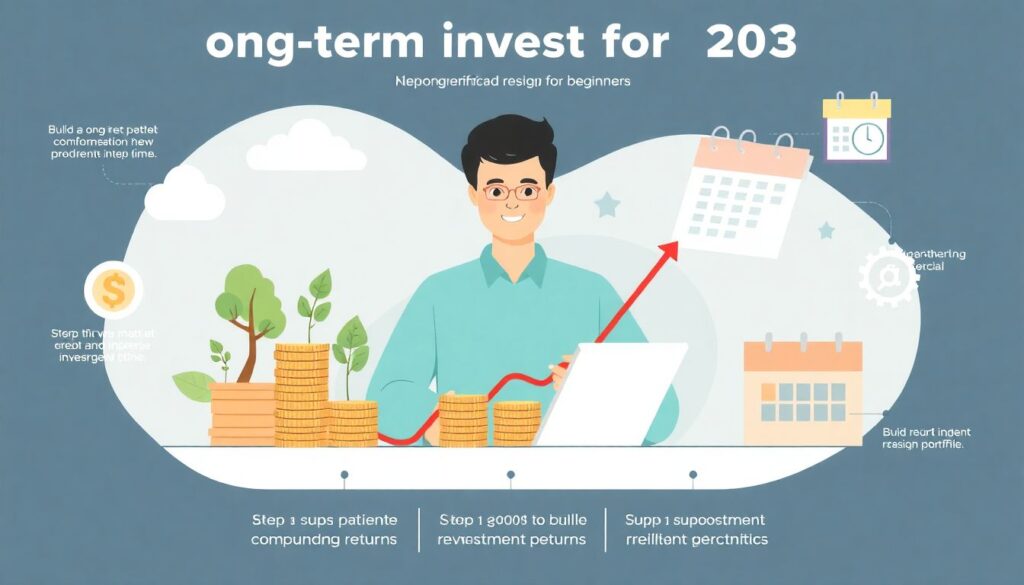Understanding Long-Term Investment in 2025
Long-term investing remains a cornerstone of personal wealth building, especially in the face of evolving market dynamics in 2025. With the rise of artificial intelligence in financial analytics, the democratization of investing through low-cost platforms, and heightened awareness of sustainable investing, beginners now have more tools and opportunities than ever. However, to succeed in long-term investment, it’s essential to understand the foundational strategies, use the right tools, and follow a structured approach.
Essential Tools for Long-Term Investing

Before diving into strategy, beginners must equip themselves with the right digital and analytical resources. In 2025, these tools are more accessible and powerful than ever:
1. Brokerage Platforms with AI Integration – Modern platforms like Fidelity, Robinhood, and eToro offer AI-driven insights, automated portfolio rebalancing, and real-time risk analysis to help investors make informed decisions.
2. Robo-Advisors – Services like Betterment and Wealthfront use algorithms to create and manage diversified portfolios aligned with your goals and risk tolerance.
3. Financial News Aggregators – Tools such as Seeking Alpha or Bloomberg Terminal (lite versions available) help track macroeconomic trends, company earnings, and geopolitical risks.
4. Sustainable Investment Screeners – ESG-focused screeners allow investors to filter stocks and ETFs based on environmental, social, and governance criteria, a growing priority in 2025.
5. Education Platforms – Websites like Coursera, Khan Academy, and Investopedia offer free and paid courses tailored to long-term investing principles.
Having these tools at your disposal empowers you to make data-driven decisions and stay aligned with your long-term financial objectives.
Step-by-Step Process for Building a Long-Term Investment Strategy

Long-term investing isn’t about chasing short-term gains. It’s about building a resilient portfolio that compounds over time. Here’s a step-by-step process tailored for beginners in 2025:
1. Define Your Financial Goals

Start by determining what you’re investing for—retirement, a home purchase, or your child’s education. Set a time horizon of at least 5 to 10 years. This will influence your asset allocation and risk tolerance.
2. Assess Your Risk Tolerance
Use online risk assessment tools provided by robo-advisors or brokerages. These tools evaluate your financial situation, investment knowledge, and emotional response to market volatility.
3. Choose an Investment Strategy
There are several proven strategies for long-term investing:
– Buy and Hold: Purchase quality assets and hold them for years.
– Dollar-Cost Averaging (DCA): Invest a fixed amount regularly, reducing the impact of market volatility.
– Index Investing: Invest in broad market indices like the S&P 500 or MSCI World via ETFs.
– Thematic Investing: Focus on long-term trends like clean energy, AI, or biotech.
4. Build a Diversified Portfolio
Diversification reduces risk by spreading investments across different asset classes, sectors, and geographies. In 2025, global diversification is easier than ever thanks to fractional shares and international ETFs.
5. Automate and Monitor
Set up automatic contributions to your investment account. Use portfolio monitoring tools to track performance and rebalance when necessary—usually once or twice a year.
Troubleshooting Common Pitfalls
Even with a solid plan, beginners often encounter challenges. Here’s how to address the most common issues:
1. Emotional Investing
Emotions can derail long-term plans. In 2025, AI-driven sentiment analysis tools can alert you when market anxiety is high, helping you avoid panic selling. Stick to your plan and revisit your goals during market downturns.
2. Over-Diversification
While diversification is key, owning too many assets can dilute returns and complicate management. Aim for 10–15 core holdings and avoid chasing every new trend.
3. Ignoring Fees
Even small fees can erode long-term gains. Use commission-free platforms and low-cost ETFs. Always check the expense ratio before investing in mutual funds or ETFs.
4. Lack of Rebalancing
Over time, your asset allocation may drift. Use automatic rebalancing features or set calendar reminders to adjust your portfolio annually to maintain your desired risk profile.
5. Chasing Hype
The rise of social investing platforms in 2025 has increased exposure to hype-driven stocks. Avoid making decisions based solely on viral content or influencer advice. Do your own research and rely on fundamentals.
Conclusion: Staying the Course in a Dynamic Market
Long-term investing in 2025 offers more flexibility, data, and access than ever before. But success still depends on discipline, education, and strategic planning. By using modern tools, following a structured process, and avoiding common mistakes, beginners can build a resilient portfolio that grows with them over decades. Remember, the goal isn’t to time the market—it’s to spend time in the market with a smart, forward-thinking strategy.

